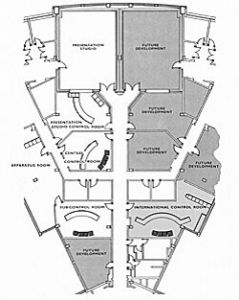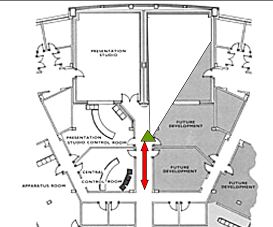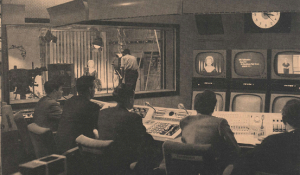Background
On the fourth floor of Television Centre, in the central wedge between TC3 and TC4, was the main network control area for what was then called BBCtv and the planned second channel. A corridor led from the lifts towards the back of the building and on either side were the control rooms, apparatus rooms, voice-over booths and from 1963 a small room containing the ‘noddy’ camera that could be remotely tilted up to look at the revolving globe logo and down to look at a clock.
At the end of the corridor was another control room on each side that looked into a pair of studios, side by side. These were presentation studios and were known by all as Pres A and Pres B. They had been designed for continuity announcers … but within a few years the BBC decided to adopt out-of-vision announcers. Thus the studios became available for other uses. They were quite small – at 32 x 22 metric feet wall to wall with a firelane crossing the middle. This could never be obstructed!
Pres B opened in about 1963/4 with EMI 201 Vidicon cameras and became the home of “Late Night Line-Up” – a daily arts and topical discussion programme – and the “Old Grey Whistle Test”.
[Adapted from http://www.tvstudiohistory.co.uk/tv%20centre%20history.htm#pres]
Pres A
Alec Bray
(Some) Members of the Tech Ops studio crews were seconded to work in Presentation B for some three months at a time. Pres B was home to “Late Night Line Up” (launched in April 1964) and the “Old Grey Whistle Test”.
We worked on the AP shift system, which meant working Saturday, Sunday, Tuesday, Thursday and Friday one week, and Monday and Wednesday the next.
Ian Hillson
The AP shift system came about, I’m told, to enable a repeat performance of the big shows that went out live over the weekend on the following Thursday and Friday- when everyone re-assembled and did it again that is (Film Recording was in its infancy and Equity used to insist that any film recording could only be made of a repeat performance. Until 1955 any telerecording made could only be viewed privately on BBC premises and not transmitted.) – this gave rise to the AP shift system of working the weekend and then the following Thursday and Friday. Yes it was great – you could get a week off by just taking leave Monday and Wednesday in the quiet week!
Alec Bray
One of the features of “Late Night Line Up” (LNLU) was that it was scheduled as the last programme of the evening before closedown. This meant that the programme could go on as long as the participants (and the director) wanted it to.
One of the best things about working on LNLU was that the studio directors always invited the crew down to Hospitality (or “Hostility” as it was generally known) after the programme. And the talk in Hospitality was often more engaging that the discussion that had just occurred in the studio. I remember Kenneth Williams talking at length about the Romans – he was very interested in, and knowledgeable about, Roman History. There was a performance on LNLU of Eric Thomson (he of “The Magic Roundabout” fame) reading Louis MacNiece’s poem “Bagpipe Music”. I asked Eric about the poem in Hospitality afterwards, and Eric dug out the piece and posted the poem to me: what generous and nice man. There was Malvina Reynolds (who wrote “Little Boxes”): I asked her, in Hospitality, if she was concerned about the differences between American English and British English when she was writing her lyrics – did some words have a different meaning across the pond – she did not really know what I was on about! (“I’m mad about my flat” at that time would mean, in English, “I am ecstatic about my new apartment” but in America “I am extremely cross about my flat tyre”.)
Most of the time LNLU was live, but sometimes there were occasions when the studio was not being used. On one such occasion, the director came down to the studio and told us that there was no programme that evening, so we could be stood down – but not to go off the premises “just in case”. Not too many places to go in TVC, so the whole crew trooped down to the BBC Club. And drank. Sometime shortly before the planned transmission time, the senior one of us got a call – we were required back in the studio and we were going live. Well, I have never been much of a drinker, but I had had four pints by this time … I can’t tell you anything about the programme, except that we managed to get through it OK…
I am in a bit of quandary, as I distinctly remember doing music inserts for “Old Grey Whistle Test” in my time in Pres B (I left the BBC in May1967) although officially the “Old Grey Whistle Test” did not start until 1971. However, Wikipedia states that “… “Old Grey Whistle Test” was originally made in a studio known as "Pres B". The studio was only 32 by 22 feet (10 m × 7 m) which left little room for a set once the cameras and band were in….”
However, we certainly did (pop) music in Pres B. One a number of occasions we had a rostrum in one corner of the studio, onto which we had to manhandle the pedestal and its camera. Luckily, the pedestal was a lightweight Vinten spring-balanced ped, the camera an EMI Vidicon, so it was not too heavy to get up onto the rostrum: but with the rostrum in place, there was even less space in the studio!
On one memorable occasion, we were doing a (rock) music program in Presentation B, and the director wanted to get a specific wide-angle shot. The studio was small – could not get the required shot. The only solution was to open the studio doors and take the camera out of the studio and down the corridor. So there I was, on shot, tracking on the (horrible) Vinten spring loaded ped, past network control, down the corridor!
Geoff Fletcher
Ah- Pres! Those dreaded memos – Go directly to Pres – Do not pass go – Abandon your mates on the crews and the joys of irregular hour working – Ally Pally shift to be the norm etc. etc. After the first stint, when I found myself in Pres A for what seemed to be forever, I quickly realised that Pres B was the place to go next time. Miraculously, I managed this twice and much enjoyed the benefits thereof – Late Night Line-Up, Colour Me Pop, drifting in at 14:00 only to have Phil Pride say "Come back at 20:00 lads", the peerless Joan Bakewell, watching Rowen and Martin as everything stopped for Goldie Hawne if Phil was directing, combing Shepherds Bush Market for Sci-Fi mags for Algy the Duty Engineer in B – thus ensuring a better chance of getting in there again on the next stint, Late Night Allowance augmenting our meagre salaries, post LNLU drinks sessions in B209 – especially on Fridays when the norm was to try and drink the hospitality "cupboard" dry before your never seen colleagues on the other half of the Ally Pally shift got to it on Saturday night (knowing it would be their turn to reciprocate in due course), a well known cameraman living in Barnes (name omitted to protect the guilty) running his photographic business very profitably from Pres B with free phone calls safe in the knowledge that when he was in danger of being sent back to a crew he could don his surgical collar (ex road accident) and claim an extension of his Pres attachment on medical grounds – Bryn Edwards were with him while this was going on and thought it an excellent wheeze! Lots of free time and lots of fun, and for a few weeks a plannable social life because of the regular shift pattern.
Tony Grant
Oh, Pres, the memories. And speaking of Algy, do you remember the time Pres A was being refurbished, and so a small studio was set up in the spur with EMI Vidicons to fill the gap. One morning I arrived around 09:30 to find Algy walking about the studio with some metal rods in his hands. When I enquired what he was up to, he told me to take one in each hand (they were metal rods in a tube, you held one tube in each hand with the rods being able to move freely inside). Now I had to start on one side of the studio and walk across the floor, holding the rods pointing straight out in front of me.
This I did, and about halfway across, imagine my surprise, as they suddenly moved outwards ALL BY THEMSELVES! Ah yes, said Algy, I found that cabling under there too.
Apparently, he’d brought in a pair of Post Office divining rods, and we had a real morning’s fun seeing what else there was under the floor. Until then, I’d have sworn that divining, etc. was an old wives tale, but now….
Pres A
Dave Mundy
Probably one of my first shifts in Pres. A started at 1200. I arrived to be told that in the studio was Richard Dimbleby on fader 1, on fader 2 was Cape Canaveral (to see the launch of the first American in space), and on fader 3 was Moscow (to see Yuri Gagarin’s welcome back to Earth)!
My so-called colleagues then said, “We’re off to lunch, good luck!’”
It was the honour of the SA2s manning Pres. A to close down BBC1 by playing the National Anthem from an LP. Unfortunately, one evening I had forgotten to fade up the grams channel and, having started the disc, I luckily faded it up between the drum-roll and the tune. No-one noticed at TC so I thought I had got away with it. However, one diligent transmitter engineer in the Outer Hebrides, who had written his close-down log and gauged the finish time from the start of the drum-roll, was thwarted as he stood with his hand on the main breaker! He, of course, complained to the Duty Engineer, Alan Foster, and I was hauled over the coals the next day.
When the SA1 manning Pres. B went on leave a Pres. A SA2 had to run Pres. B, what an experience! “Early Evening Line Up” needed a music track lasting about 43 secs. I think. I spent ages editing a 1/4 in. tape of Dave Brubeck’s “Take Five”, among many other favourites, to fill the slow pan round the evening’s caption boards. Happy days! Then a new Head of Presentation insisted on having ‘real’ Sound Supervisors in Pres. so the likes of Len Shorey, Hugh Barker etc. were doing the weather forecasts, trails, and “Points of View”, and the junior sound staff lost all their valuable mixing experience, Did anything improve?
Tony Grant
The first time I ever ‘mixed’ sound live, on air, was in Pres A when whoever was meant to be there (SA1/2 or SS, don’t remember) didn’t turn up on time. I managed a few trails and weather forecast, and eventually the latecomer arrived, having had some dreadful transport, or lack thereof, catastrophe befall him.
On a separate issue, and back to S. Tel. E.s ,just after Pres A had had yet another refurbishment, and I was once again directing the lunchtime weather in A, with a certain TK doing the lighting. A problem arose with his lighting control panel about ten minutes before we were due to go on air, and he frantically fiddled with knobs switches and faders for a few minutes without any luck, and by the time we had the two minute flashing lights he was running up and down the corridor outside yelling ‘I’ve lost control, I’ve lost control……’ I turned to the sparks and asked him to turn the lights on in the studio via his panel there, and all went ahead as normal, thankfully. I never did find out what had gone wrong with the lighting control panel.
When I was doing my stint as Assistant Producer in Pres, I was talking to Albert Barber and he mentioned a certain S. Tel. E. and asked had I worked with him. I wasn’t sure, but Albert said that the most remarkable thing about him was that if anything went seriously wrong, he sounded just like ‘Beaker’ in “The Muppets”. I said I couldn’t recall anything of the sort, so I wasn’t sure if I’d met him.
However, this S. Tel. E. usually worked in Network Control, and on one Saturday afternoon after sitting through a few hours of “Grandstand”, BBC1 went to the news. After the news, each region opted out to present its own local sports news for about five minutes. So I’m sat there, nominally the network director, and after we’d been on the news for a couple of minutes, the S. Tel. E.’s phone rang, and almost immediately I heard ‘Beaker’. I have to say, it was the uncanniest and most accurate description of the noise he made, so I knew something was seriously amiss. Apparently it was the T.M. in LG Studio E ringing to say that the fire alarm had sounded, so they were all leaving the building, and there would be no S.E. sports report. I have to say I was seriously impressed by the network editor’s organisation, as within a few minutes there was a Tom and Jerry Cartoon loaded into a TK machine, and all I had to do was to inform the regions that they shouldn’t expect to opt back to us for an extra 30 seconds, or so.
Funnily enough, at the end of the furore, the only complaint I had was from Norwich, wanting to know what the expletive deleted we were doing showing Tom and Jerry, to which I gently replied that they were supposed to listen to my talkback and/or watch Presfax.






